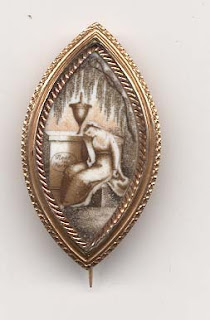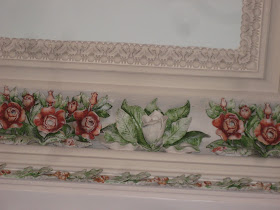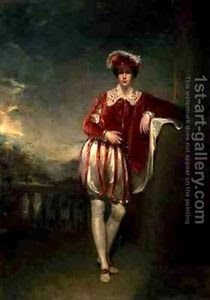Soldier weeping at the tomb of Napoleon l miniature painting 1820's
I started to collect mourning/sentimental jewelry over 10 years ago when you could get 18k gold pieces with rose cut diamonds for $50 bucks on ebay. I stopped collecting when I had over 200 pieces of high end Georgian and Victorian mourning jewelry dating from 1760-1860. Now most of the pieces I paid $50 bucks for are going for $500. and up on ebay. Over the years I have loaned out my collection to museums for Mourning exhibits for the month of October.
I first became interested in hairwork mourning jewelry at the age of 10 after touring a 1833 Greek Revival Historic House Museum in Mobile, Alabama called Oakleigh Mansion. In the master bedroom in a French display case was a small collection of mid 19th century mourning hairwork jewelry own by 19th century Mobilions. I was festinated with the stuff. It was woven as fine as lace but was made of human hair and gold. In my late teens I started to collect pieces of the popular 19th century art. In my hay day I had five packages a day of Old Paris porcelain and hair and gold Mourning jewelry coming in from the mail man.
I also collected Mourning portraits and a few other items connected to Mourning. Although today it seams like the average person has little time to mourn a death. In the 18th and 19th century mourning could go on for years are a life time. The first major person to die in America was the death of the country's father on December 14, 1799. George Washington's demise inspired the commercial production of songs, poems, images, and memorabilia in his honor well into a hundred years after his death as a sign of prolonged mourning. Middle class and wealthy lady's embroidered colorful silk scenes of classical figures crying at the tomb of Washington that proudly hung in parlors along with family oil portraits. If you were poor maybe you could afford a hand colored mass produced engraving of the same scene. Or if you were a close friend of Washington or family member you might get a miniature portrait of his likeness on ivory painted by a fashionable artist of the day with his hair on the back.
By the middle of the 19th century having a period of mourning was becoming cheaper due to the Industrial Revolution making every class of people able to afford to be fashionable and to display mourning art or a photo of the dearly departed. Not only did people dress in mourning, but wealthy people eat off of specially made porcelain dinner services painted in black. They wrote on mourning stationary outlined in black. A home was decorated outside and in, in mourning. Books were published on mourning protocol. In the 19th century Mourning was big bucks. English Queen Victoria mourned her husband death prince Albert until her death in 1901. Today hairwork jewelry and mourning portraits are a lost art. But the Attention to Detail that went into pieces are amazing and exquisite making mourning art rare, beautiful & interesting to today's viewers. I glade I collected my pieces when I did as the prices keep going up.
1790 Navette shaped Mourning brooch On the tomb are the words, "Rest in Peace".
Written on this Georgian memorial brooch is, "John Kempson ob. 30 of May 1783 Ae 20". The picture on this brooch is hair on ivory surrounded with garnets.
English 15k gold Victorian brooch On the back is brown woven hair and the inscription, "Frances Chalmers obt 12 May 1853".
Cupid and woman decorating a tomb with roses late 18th century. The pearls represent tears
Belt ring made of woven hair, pearls and blue enamel Georgian early 19th century
A dog (symbolizing fidelity/loyalty) is looking up at the word "fidelity" which the woman is holding in her hand. To emphasis the depth of her love and loyalty, the woman is holding a cage or basket with the word "fidelity" in it. The beautiful paste stones and cobalt blue enamel really make the sepia painting stand out.
Mourning jewelry worn by Mrs. Joel Gutman of Baltimore, Maryland in 1865.
Early 19th century Georgian brooch made of gold get and rose cut diamonds in the shape of a forget-me-not flower
Portrait miniature of George Washington with his hair on the back sold by Skinner auction Feb 2009 for $336,000.00
Locket with locks of George Washington and Martha Washington’s hair Sold at James D. Julia Auctions August 5, 2009 for $ 7,475.00
Sentimental Portrait of George Washington, 1789 watercolor on ivory by John Ramage half-length, wearing the blue uniform of a General with yellow facings, and gold epaulettes, yellow waistcoat and lace cravat, and the Order of the Cincinnati, powdered hair en queue. Gold frame, the reverse with gold monogram GW on plaited hair in navette aperture within engraved inscription navette shape.
Early 19th century engraving weeping at the tomb of Washington
Mrs.Washington, painted two years after her husband's death
Bernard Duchamp c. 1822, Born in Bordeaux, France, Bernard Duchamp immigrated to New Orleans prior to 1814. During the Battle of New Orleans, he served with the American forces. A prosperous commission merchant, he married Marie Theodore Basilica Pédesclaux, daughter of New Orleans notary public Pierre Pédesclaux, in 1820. They maintained a residence on Royal Street in the Vieux Carre. Around 1822, Duchamp hired someone to paint his likeness. The unknown portraitist, probably an itinerant painter traveling through the south, followed the prevailing French Neoclassical tradition of portraiture particularly popular in Louisiana at the time. /collections of the “Louisiana State Museum, Gift of Mrs. P. Malarcher.”
The Bernard Duchamp Family Mourning Portrait c. 1832 is unusual in that the bereaved family is shown dressed in black mourning clothes beside their beloved father’s draped portrait. Bernard Duchamp’s death left behind his widow and five children. The bright ethereal light coming from the window on the left of the painting alludes to the eternal afterlife. / collections of the “Louisiana State Museum, Gift of Mrs. P. Malarcher.”
Creole Family Mourning Portrait, New Orleans 1830's by Tomassin
Marie Antoinette in her black velvet mourning dress in the Temple Tower.
All Souls Day - 1859 by William Adolphe Bouguereau
Early 19th century Mourning portrait of children at a tomb.Note Guardian Angel and children with orange coral jewelry to ward off bad sprits.



























































